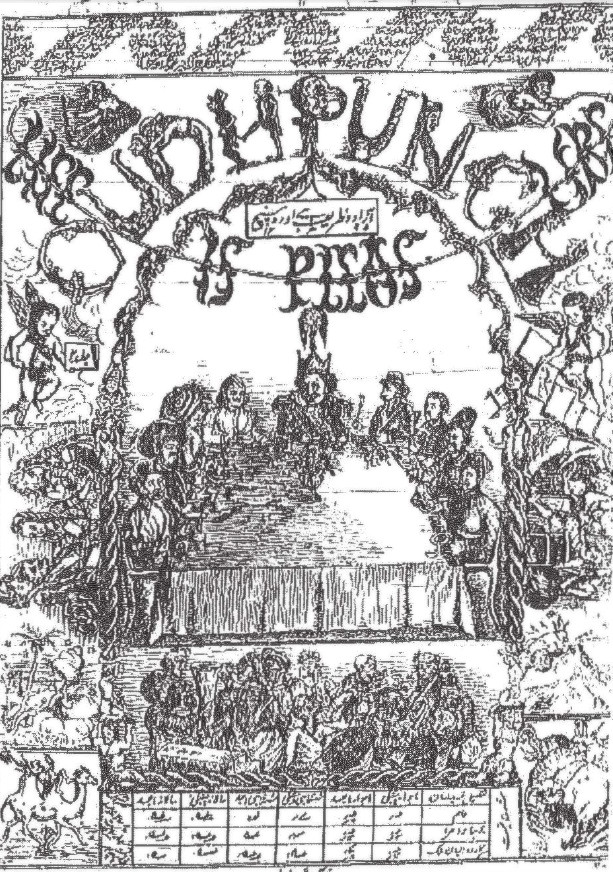The following is the last of several extracts from the author's "A Comic Empire: The Global Expansion of Punch as a Model Publication, 1841-1936," originally published in the International Journal of Comic Art 15/2 (Fall 2013): 6-35. We are grateful to Professor Scully for allowing us to reprint some passages from it here, but the ones in this part come from our own website. Please click on them to enlarge them, and for more information about them. — Jacqueline Banerjee

Ganga Sahai ["Shauq"]. Cover illustration. Awadh [Oudh] Punch, c.l887. Source: Scully 14.
[T]he Awadh Punch (1877-1936) ... was founded in the important imperial provincial capital of Lucknow as a mirror to the London Charivari, and its apparently modest regular circulation of between 230 and 400 copies in the 1870s (Khanduri 471) belies its importance for the development of Indian political comic art. Its founder and "indomitable commander" (Hasan, Wit and Humour, 10), Sajjad Husain (1856-1915), was the son of one of the Nizam of Hyderabad's senior tax collectors (Khanduri 471), and used his paper to advocate for the extension of socio-economic (Hasan, Wit and Humour, 37-45, 53-63) and political rights for Indians (63-72), but always with an eye to the supremacy of the Muslim cultural elite (91). Printed in the local Urdu language, the magazine commented widely on international affairs, as well as the corruption of the British establishment, adapting many London Punch cartoons for its own purposes (Mitter 158-59; Hasan 36-37). In this, cartoonists such as Wazir Ali, Lal Bahadur, "Musawwar," and "Shauq," ... were prompted by a desire to undermine a sense of "Britishness," rather than reinforce it. It was not only Punch cartoons which were plagiarized or subverted, but also ones appearing in Punch's rival papers, Judy, and Fun, indicating that they, too, circulated as far afield as the Raj (Hassan 42, 80). Just as the London Charivari was a model publication for a global comic cultUre, so. too the Awadh Punch inspired numerous imitators and competitors in its oWn right. By Mushirul Hasan's count (12), at least 70 were founded in India by 1900, in cities as widespread as Kolhapur, Allahabad, Calcutta, Madras, and Gujarat (103). Not all were independently-minded nationalist papers; there were also broadly pro-British Punches that emerged in India — including the Hindi Punch (1878-1930) — which incorporated "professions of loyalty'' (Mitter 156) and attempted to be good empire loyalists in [their] attitudes (Khanduri 470). The Punches published by "moderate" supporters of the Indian National Congress (such as Sir Phirozshah Mehta of Hindi Punch) would thus assist in counterbalancing those more radical supporters of independence (such as Sajjad Husain and Awadh Punch), which were in any case closely monitored by the authorities. It is from the records and post-marks that formed such an important aspect of the British imperial state that Khanduri (470-71) has been able to build up a picture of who read these papers: e.g. Awadh Punch was read in various universities — including as far away as Calcutta and Allahabad — as well as in Lahore in the North-West Provinces.
Despite their apparent importance, the Awadh Punch and its numerous counterparts were first examined only recently. This is partly because Indian cartoonists and scholars have tended to see the London Punch as the and the originator of their tradition, and in so doing, are actually perpetuating an old imperial strategy which, in denying the legibility of colonial Indian cartoons and dismissing them as pale (or perhaps, "dusky") imitators of the "genuine article," were equally harping on "the incompleteness and impossibility of colonial modernity and liberalism" (Khanduri 476). It is therefore odd, as Ritu Khanduri has noted, "that Punch and not the vernacular publications have became [sic] the vanishing point for narratives of Indian cartooning" (460); after all, the London Punch was never as popular or successful in India as its imitators. The answer to this quandary probably lies in anti-colonial politics as much as a myopia concerning these provincial papers: Mushirul Hasan, in Wit and Humour in Colonial North India (103-109), has shown how the Awadh and other similar papers eventually became obsolete as a more strident form of nationalism took hold (so too has Mitter 158). Awadh Punch's very role in helping sustain a strong culture of high-class Nawabi, anti-British identity over several decades, made it incompatible with the new Indian national narrative after 1947, and hence, it was forgotten. As Khanduri points out (470), and as alluded to above, the various vernacular Punches were also — certainly by the 1890s — in intense competition with one another, and, thus, did not provide the unifying national story required of post-independence histories of the anti-colonial press. [23-25]
Related Material
- 1. Punch's Colonial and other imitators
- 2. Regional and American imitators of Punch
- 3. Maintaining British Identity Abroad through Punch
- 4. Colonial Charivaris
Bibliography
Hasan, Mushirul. Wit and Humour in Colonial North India. New Delhi: NiyGgi, 2007.
Khanduri, Ritu G. "Vernacular Punches: Cartoons and Politics in Colonial India." History and Anthropology. 20/4 (December 2009): 459-486.
Mitter, Partha. Art and Nationalism in Colonial India, 1850-1922: Occidental Orientations. Cambridge: Cambridge University Press, 1994.
Created 15 August 2019